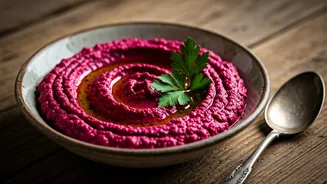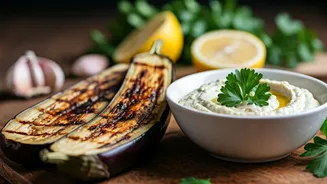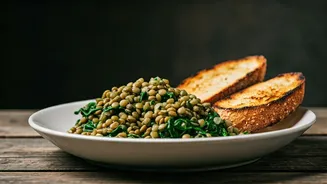Origins and Inspiration
Mutabal Shamandar, translating to 'beetroot dip', is a Middle Eastern culinary gem that celebrates the earthy sweetness of beetroot. It's a variation of the classic
Mutabal, which typically features eggplant. This version substitutes roasted beetroot, offering a unique flavor profile. The dip’s creamy texture comes from tahini, a sesame seed paste, blended with lemon juice, garlic, and often, yogurt or olive oil. Its simplicity belies its delicious complexity, making it a beloved appetizer. The dish has evolved through time, and remains a testament to the region’s use of fresh, flavorful ingredients, creating dishes that are as visually appealing as they are delectable. The versatility of Mutabal Shamandar allows for endless creativity in presentation and pairings, enhancing its appeal across diverse culinary landscapes. The balance of sweet, tangy, and savory flavors has contributed to the dip's broad appeal.
Essential Ingredients
To create Mutabal Shamandar, you will need a few key ingredients. First, the star: fresh beetroot, chosen for its deep color and sweetness. Roasting the beets concentrates their flavor, adding depth to the dip. Tahini, a staple in Middle Eastern cuisine, provides a rich, nutty base. Lemon juice adds a bright, acidic counterpoint that balances the sweetness of the beets and the richness of the tahini. Garlic offers a pungent aroma and savory kick, enhancing the overall flavor. Olive oil contributes a smooth texture and enhances the flavors. Yogurt, optionally, provides creaminess and a slightly tangy taste. Salt and pepper are essential for seasoning, bringing all the flavors into harmony. Optional garnishes such as chopped parsley or a drizzle of olive oil, and some extra beets for decoration offer a delightful visual appeal.
Roasting the Beetroot
Roasting beetroot is a crucial step in preparing Mutabal Shamandar. Begin by preheating your oven to 200°C (400°F). Wash the beets thoroughly and remove any dirt. Wrap them individually in aluminum foil or parchment paper to lock in moisture and flavor. Place the wrapped beets on a baking sheet and roast for approximately 45-60 minutes, or until they are tender when pierced with a fork. The roasting process caramelizes the natural sugars in the beets, intensifying their flavor and creating a deeper sweetness. Allow the roasted beets to cool slightly before handling. This step ensures that the dip is packed with flavor, and adds a level of complexity that raw beetroot cannot achieve. The residual heat will continue to cook them gently, ensuring they become beautifully tender and easy to puree for the dip.
Making the Dip
Once the beets are roasted and cooled, you can proceed to make the dip. Peel the beets, discarding the skins. Chop them roughly, and place them in a food processor. Add tahini, lemon juice, minced garlic, olive oil, and optionally, yogurt. Season with salt and pepper to taste. Process the mixture until it reaches a smooth, creamy consistency. If the dip is too thick, add a tablespoon of water at a time until the desired texture is achieved. This step is about balancing flavors and achieving the perfect texture. The tahini should be well-incorporated, providing a rich, nutty flavor, while the lemon juice adds a bright counterpoint. Experiment with the garlic quantity to adjust the flavor profile to your preferences. Remember to taste and adjust the seasoning as you go to ensure the dip is perfect.
Serving Suggestions
Mutabal Shamandar is incredibly versatile, making it an excellent appetizer or side dish. Serve it with warm pita bread or fresh vegetables for dipping. The vibrant color of the dip makes it visually appealing on any table. It also pairs well with grilled meats, falafel, or shawarma, adding a refreshing contrast to richer dishes. You can garnish it with a drizzle of olive oil, a sprinkle of chopped parsley, a sprinkle of paprika, or a few toasted pine nuts for added visual appeal and flavor. The dip can be prepared in advance and stored in the refrigerator for several days, making it ideal for meal prepping or entertaining. Its complex flavors make it a versatile addition to any meal, enhancing the dining experience.











